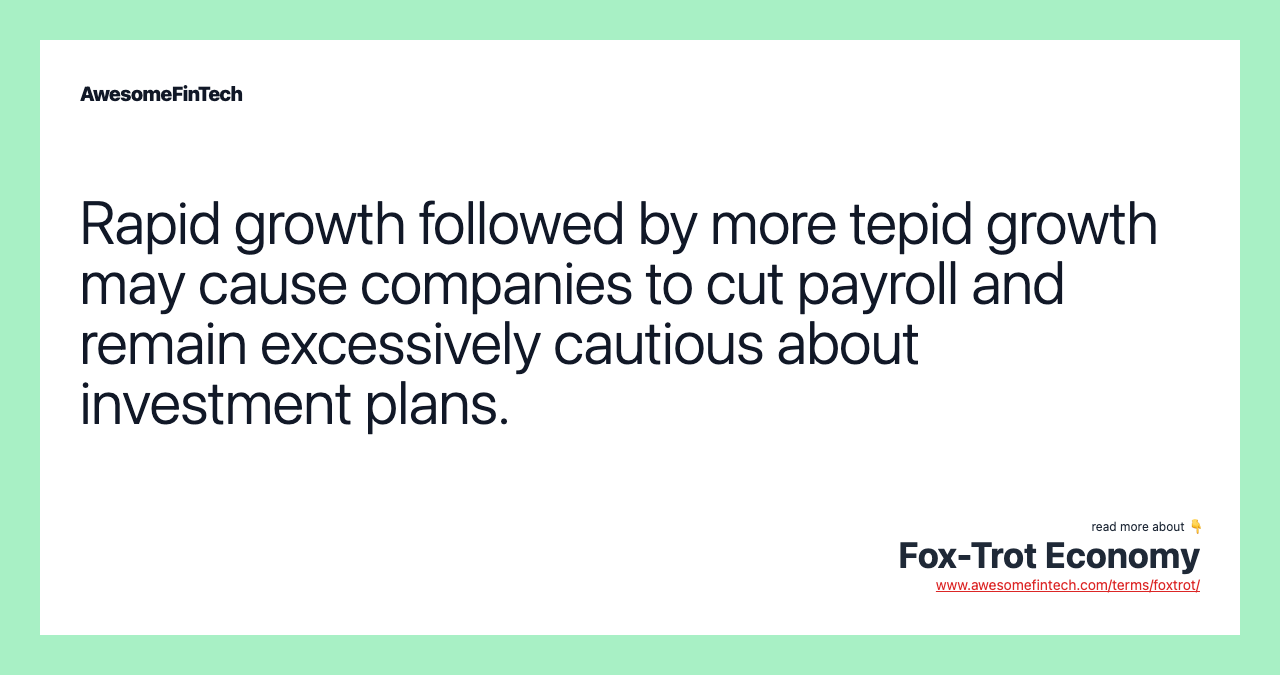Fox-Trot Economy
A "fox-trot economy" refers to a pattern of economic growth where periods of rapid expansion are followed by periods of slow growth. An economy that goes through a period of fast growth followed by a period of slow growth, while still showing overall growth throughout the cycle, mirrors the fast-step, slow-step movements of the fox-trot, as the dancers continue to move throughout the dance. In a fox-trot economy, greater economic uncertainty regarding potential financial or economic shocks can result in volatility in the rate of macroeconomic growth, which in turn can lead to lower rates of return on many assets and higher risk premiums on business borrowing. Likewise, the demand for borrowing and lending affects an economy's interest rates, and as economic growth slows and companies borrow less, interest rates may decline, leaving savers with a lower rate of return even as they might like to save more in order to insulate themselves from economic volatility. Although the expectation in a fox-trot economy is that economic growth will pick back up again, identifying the timing of the return to rapid growth is challenging.

More in Economy
What Is a Fox-Trot Economy?
A "fox-trot economy" refers to a pattern of economic growth where periods of rapid expansion are followed by periods of slow growth. Economic growth occurs when an economy's ability to produce more goods and services increases from one period to the next, which can result from such things as more workers entering the workforce or advances in technology.







Understanding a Fox-Trot Economy
The ability to grow an economy and create economic growth can occur rapidly or more slowly, and it may even decrease. Many different factors can influence the rate of growth in an economy, and the rate will usually vary over time. Although there are no concrete rules that accurately predict exactly how an economy will grow, patterns of economic growth can still be described, and the fox-trot economy is one such pattern.
The term "fox-trot economy" is attributed to investment strategist Jeffrey Saut, an executive at Raymond James. He coined and popularized the phrase in the early 2000s to describe economic growth at the time.
The term is based on the popular fox-trot ballroom dance. In a well-known version of this dance, participants complete steps in a pattern of two fast steps that are followed by two slow ones. An economy that goes through a period of fast growth followed by a period of slow growth, while still showing overall growth throughout the cycle, mirrors the fast-step, slow-step movements of the fox-trot, as the dancers continue to move throughout the dance.
The Impact of a Fox-Trot Economy
A fox-trot economy can be challenging for investors. Although the expectation in a fox-trot economy is that economic growth will pick back up again, identifying the timing of the return to rapid growth is challenging.
In a fox-trot economy, greater economic uncertainty regarding potential financial or economic shocks can result in volatility in the rate of macroeconomic growth, which in turn can lead to lower rates of return on many assets and higher risk premiums on business borrowing. Economists have documented clear links, both theoretically and empirically, from the volatility of economic fundamentals to stock market volatility.
In a fox-trot economy, corporate earnings may exhibit higher volatility than is typical over a normal business cycle with level economic growth. This can directly impact a company's valuation. Rapid growth followed by more tepid growth may cause companies to cut payroll and remain excessively cautious about investment plans, even though the economy, in general, is growing, albeit at a slower pace. Investors, businesses, and consumers may shift more of their savings and investments to more relatively stable foreign markets.
Likewise, the demand for borrowing and lending affects an economy's interest rates, and as economic growth slows and companies borrow less, interest rates may decline, leaving savers with a lower rate of return even as they might like to save more in order to insulate themselves from economic volatility. The loss of return on savings and the decline in jobs may impact the demand for goods and services from an economy's citizens.
In general, corporations, investors, and market participants prefer predictable, steady growth, as it is easier to manage and plan from. Conversely, many traders and investors prefer volatility, as increased volatility can amplify profits if an investor understands the technical and fundamentals behind the market movements.
Related terms:
Business Cycle : How Is It Measured?
The business cycle depicts the increase and decrease in production output of goods and services in an economy. read more
The Conference Board (CB)
The Conference Board (CB) is a not-for-profit research organization which distributes vital economic information to its peer-to-peer business members. read more
Depression
An economic depression is a steep and sustained drop in economic activity featuring high unemployment and negative GDP growth. read more
Earnings
A company's earnings are its after-tax net income, meaning its profits. Earnings are the main determinant of a public company's share price. read more
Economic Shock
An economic shock is an event that occurs outside of an economic model that produces a significant change within an economy. read more
Economic Growth
Economic growth is an increase in an economy's production of goods and services. read more
Financial Accelerator
A financial accelerator is a means by which developments in financial markets amplify the effects of small changes in the economy. read more
Fundamental Analysis
Fundamental analysis is a method of measuring a stock's intrinsic value. Analysts who follow this method seek out companies priced below their real worth. read more
Goldilocks Economy
A Goldilocks economy has steady economic growth, preventing a recession, but not so much growth that inflation rises by too much. read more